BACKBONE – Used in reference to scrollwork, the backbone is the main spiral upon which the leaves and tendrils are formed. The backbone may be cut with a
single line or engraved with a wiggle tool pattern as in Western bright cut engraving. The backbone may also be implied, rather than cut, by the convergence of
leaves along a spiral shape.

The illustration shows a simulated sideplate on which are drawn the backbones of scrolls that will later be engraved.
|
BACK-CUT – A return cut over the same line with a different graver or with the graver tilted in a different direction from the primary cut. In flare cut or
double bevel scroll, each leaf is made up of a primary cut and a back cut.
|
BACKGROUND – The area that surrounds scroll or floral work. Background is usually matted with a punch or liner in bas-relief work and cut away with a
graver in medium or high relief work. The engraved scroll or figures are the foreground as contrasted with the background. German: "Hintergrunds."
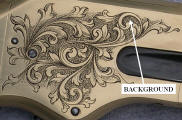 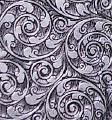 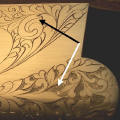
The photo at left shows background treated with a circle punch on a rifle engraved by Roger Bleile in 20007. The center photo shows background treated with
parallel lines on a shotgun engraved at the Franz Sodia factory in Austria. The photo on the right shows work in progress of scrollwork on a Browning shotgun. The
black arrow points to the untreated background and the white arrow points to background cut away and textured.
|
BACKGROUNDING – Hand Engraver’s slang for stippling, matting or removing the background metal from a design. Backgrounding is one of three basic tasks in
the engraving of ornamental designs. These three are: outlining, shading, and backgrounding. There are styles of engraved ornamentation that omit either
backgrounding and/or shading. For instance sculpted relief ornament is not shaded as shading is only a substitute for actual relief. Flare cut scroll requires
neither shading nor backgrounding as the beveled outlining cuts create a relief appearance that contrast with a plain background.
|
BACKSTRAP – That part of a pistol or revolver that forms the rear of the grip, usually made of steel or brass. Some guns are only engraved on the backstrap
because that is the part that shows when the pistol or revolver is in a holster. The back strap is the primary place for inscription on a handgun.



Shown at left is the backstrap (red arrow) of a Colt SAA engraved by Ken Hurst of Robersonville, NC. At center is the backstrap of an antique Colt SAA engraved
with a wiggle tool in an entwining motif. At right is the backstrap of a Browning High Power decorated by a factory based engraver in what Browning calls their
"Renaissance" style.
|
BANK NOTE STYLE ENGRAVING – A method of engraving a figure or scene into metal with very fine lines so that the subject looks almost like a photograph to
the naked eye. Also known as fine line engraving. Bank note engravers execute this style on printing plates in reverse so that when the cuts are inked the subject
has a high degree of realism when printed, as in presidential portraits on currency. Ornamental engravers execute the bank note style in the obverse on various
objects so that the subject is viewed directly.
In French this technique is known as "taille-douce" meaning copper plate engraving. In German the term is "flachstichgravuren."
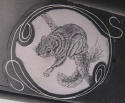 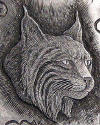  
Photo at left shows a flying squirrel c. 1977 and next right a lynx both engraved in bank note technique by Carl B. Bleile. Center right shows a banknote engraved
pheasant in flight by Steve Lindsay At far right a tiger scene engraved by C. Roger Bleile in 1981.
|
BAROQUE – Of, relating to, or having the characteristics of a style of artistic expression prevalent especially in the 17th century that is marked generally by
use of complex forms, bold ornamentation, and the juxtaposition of contrasting elements often conveying a sense of drama, movement and tension. Engraving in the
baroque style was first seen on the arms and armor of the 17th century. Much of the engraved ornamentation used today on fine jewelry, knives and guns exhibits
baroque design elements.

Shown here is a buckle, burin engraved c.1982 by C. Roger Bleile, with a Baroque motif.
|
BARS – The horizontal cuts or lines in block letter engraving.
|
BAS RELIEF – Low relief.
|
BAT WING – A decorative motif used as a border design loosely resembling the wings of a bat.

Depicted here is a bat wing motif used as decorative filler on the bolster of an Austrian over & under shotgun.
|
BEADING – Creating tiny hemispherical domes in the surface of metal with a beading punch. Beading is commonly found as background treatment of scroll
engraving.

Shown here is scrollwork that has background textured with a beading punch.
|
BEADING PUNCH – A hand punch used for creating tiny hemispherical domes in a metal surface such as found in the background of scrollwork. Sometimes called
a “circle punch.”
|
BELGIAN SCROLL – A light, open scroll having a single line spiral backbone and smaller single line spirals within and single line tendril flourishes.
Common on Belgian made Browning arms but used on a variety of Belgian guns dating to the 19th century.
 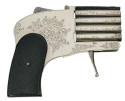 
At left is pictured the receiver of a Pigeon Grade Browning Superposed shotgun decorated with Belgian scroll. At center is an antique Belgian pistol (note Liege,
Belgium proof marks on barrels) engraved with Belgian scroll. At right is a Belgian scroll engraved trigger guard.
|
BENCH PIN - Used for filing and sawing. The bench pin is Usually made of wood and is attached onto the edge of the bench. It is used by engravers for
support while sawing out sheet metal to be used for inlay. Also used for saw piercing.

Pictured here is an unmounted bench pin.
|
BENCH VISE – A vise with a fixed mounting. Hammer and chisel engravers us a
 bench vise mounted on the corner of a bench or to a projection attached to a
bench. Some H&C engravers have their vise mounted on a post so that they can walk around the vise as they engrave. Italian: Morsa da banco. bench vise mounted on the corner of a bench or to a projection attached to a
bench. Some H&C engravers have their vise mounted on a post so that they can walk around the vise as they engrave. Italian: Morsa da banco.
Pictured here is the late Lynton S. M. McKenzie engraving with hammer & chisel and using a post mounted bench vise.
|
BENCH STONE –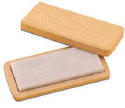 A hard, flat, rectangular stone used for manual sharpening of blades, chisels, and gravers. Hard Arkansas, India, and ruby stones are often
used as bench stones. A hard, flat, rectangular stone used for manual sharpening of blades, chisels, and gravers. Hard Arkansas, India, and ruby stones are often
used as bench stones.
|
BIGGS OCEANIA SCROLL – A unique style of engraved scrollwork developed by New Zealand engraver Andrew Biggs who incorporates Maori and New Zealand design
elements into the theme of his work.
|
BLACKLEAF – Also known as German floral, or in Germany and Austria, as Altdeutscher Laubgravur is a style of ornamentation consisting of leaves and stems
arranged in swirling or spiral patterns. Blackleaf is a popular style of engraving on European and British shotguns and double rifles.

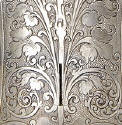
At left is shown blackleaf scroll as engraved by Winston G. Churchill of Vermont on a Remington rifle. At right is another version of blackleaf scroll as engraved
on a German shotgun.
|
BLOCK (ENGRAVER’S) – A special vise used by hand engravers. The block is usually spherical, with adjustable jaws on top and usually sits in a felt,
leather, nylon, or rubber ring. Known in earlier times as an “engraver’s bullet.” Italian engravers refer to the block as "morsa da tavolo" (table vise). German
speaking engravers call the block the "graveurkugel." In French "etau a boule."
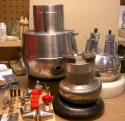   
The picture at left shows a large 45-pound LeTerneau block (left rear), a medium sized, 20-pound Vigor block (right rear), and a small 7-pound A.D.Muhlmatt block
(front) and work holding accessories in the left foreground. The next picture shows the Muhlmatt block alone. Next right is a picture of the late John Warren
engraving with hammer & chisel on work in a Victor block. At far right is a block shown with accessories for various work holding.
|
BLUEING – The process of creating a gun-blue finish on steel through the application of an acid solution or chemical salts that artificially induces rust.
By means of controlled rusting and brushing or immersion into a heated salt bath, the surface of the steel acquires a blue or blue-black finish that minimizes
light reflection and secondary rust formation.

Shown here is a blued replica of an 1890 Remington revolver made by the Italian firm of A. Uberti and engraved in flare cut scroll by C. Roger Bleile.
|
BOLSTER – 1) On guns, a bolster is a raised reinforcement on the receiver of a side-by-side or over/under rifle or shotgun. 2) On knives, a bolster is a
metal portion of the grip adjacent to the grip material. Knives do not necessarily have bolsters, as their function is mostly decorative. Some knives have two
bolsters and some have four, two nearest the blade or hinge pin and two at the butt.
_small.jpg)
JPG_small.jpg)
At left is shown the engraved bolster of a Franz Sodia shotgun. At right is the bolster of a custom made knife engraved in Lindsay style scroll by C. Roger Bleile.
|
BOUQUET AND SCROLL - This style of arms decoration consists of a combination of small English scroll and clusters of flowers (usually roses). Also known as
rose and scroll. French: Anglaise a bouquet, German: Rosenbukett mit altenglischen Arabesken, Italian: Inglesina e bouquet di fiori.


_small.jpg)
Pictured are three examples of bouquet & scroll (aka: rose & scroll) engraved on British shotguns.
|
BRIGHT CUT/ WESTERN BRIGHT CUT – A style of engraving commonly used on western silver jewelry and riding gear such as spurs, bits, Conchos, and saddle
ornaments. This type of engraving is occasionally found on firearms, knives and banjos. Cuts that appear to be deep and reflective and scrolls whose backbone
is executed with a wriggle tool pattern characterize bright cut engraving.
For additional information on the process of Western bright cut engraving, as explained by Brian Hochstradt, click this link:
http://www.handengravingforum.com/showthread.php?t=2943
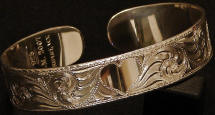
Pictured is a bracelet engraved in the "bright cut" style by Chris
Malouf of West Virginia.
|
BROWNING – An acid and water oxidation process that was common in the 18th and 19th centuries for coloring steel brown. Contemporary long rifle makers use
this process today in the production of hand made Kentucky and Pennsylvania rifles which are often ornately engraved.
|
BRUNISSOIR – French: Burnisher, a hardened and polished steel hand tool used by engravers for rubbing down transfer patterns or removing light scratches
from metal being engraved. The burnisher can also be used to create highlights
|
BUILD-UP - While engraving certain metals, such as aluminum, brass, or copper, a deposit of the metal will build up on the heel of the graver causing a
dulled appearance to the cut. Engravers dip the tip of the graver into any of a number of preferred oils to prevent build-up. Also known as “picking-up” or
“loading.”
|
BULINO – The Italian word for burin (hand graver), The term “bulino engraving” is used by some to describe a style of engraving scenes and figures
popularized by contemporary Italian arms engravers. This technique is executed using a finely pointed burin that is used to create very fine dot patterns. The
resultant engraving is similar in appearance to pictures that have been printed using a half tone screen and can present a highly realistic image.
A more detailed explanation of the bulino technique by engraver Steve Lindsay can be found at this link:
http://www.engravingtraining.com/private/dots.htm
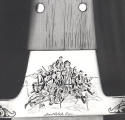


At left is a bulino type engraving by Carl B. Bleile done in 1978. It depicts Custer’s last stand. This scene was executed on a knife bolster in a space of little
more that one square inch.
In the center is a classical image engraved by Steve Lindsay in the bulino technique.
At right is a selection of burins, which are known as bulini (singular-bulino) in Italy.
|
BURIN – A hand graver. A small engraving chisel with a mushroom-shaped handle meant to be held and powered by the hand and arm. Usually used for engraving
soft metals such as gold, silver, copper or unhardened steel. Arms engravers use the burin for shading and fine detail. In Italy a burin is known as a "bulino."
Burin is also the French word for chisel.
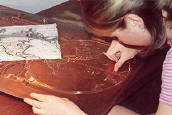
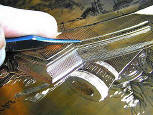
The picture at the top left shows an assortment of burins. The second picture shows the late Harry Kell, of London, engraving with a burin on a shotgun receiver held
against a "peg." The next picture is the late George Sherwood, of Winchester, Oregon, engraving with a burin on work held in an engraver's block. The
first picture in the second row is noted Czech engraver Lucie Krulíčková using a burin to engrave a copper plate from which a map of the world was printed.
The last picture right can be seen Krulíčková's burin engraving the copper plate.
|
BURNISH and BURNISHING – To create a smooth, shiny surface by compressing the outer layer of metal by applying pressure with a polished steel tool
known as a burnisher.
|
BURNISHER – A hardened and polished steel hand tool used by engravers for rubbing down transfer patterns or removing light scratches from metal being
engraved. The burnisher can also be used to create highlights. French: "Brunissoir."
|
BUTT PLATE – A covering of metal, horn, plastic, or rubber to cover the end of the stock of a rifle or shotgun. Often engraved on presentation grade
arms.

Pictured is a butt plate engraved and gold inlayed by Chris Malouf of
West Virginia.
|
BUTT STRAP - That part of a pistol or revolver that forms the bottom of the grip, usually made of steel or brass. Engraved handguns usually have some
scroll on the butt strap because it is most visible when holstered.
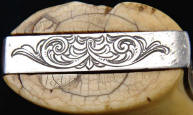
Shown here is the engraved butt strap of an antique revolver.
|